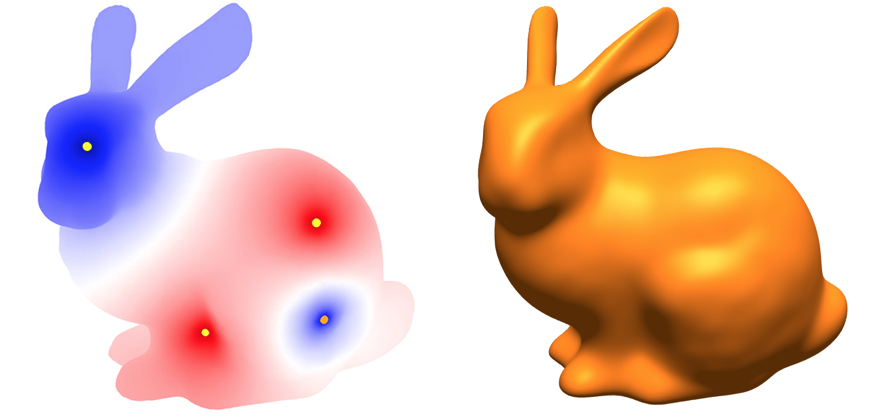
In the slides we derived a Steiner formula for polyhedral surfaces in \(\mathbb{R}^3\), by considering the Minkowski sum with a ball and working out expressions for the areas and curvatures associated with vertices, edges, and faces. But we can also get a Steiner formula for smooth surfaces, using the expressions already derived in class. In particular, recall that for a closed surface \(f: M \to \mathbb{R}^3\) with Gauss map \(N\), we can obtain the basic curvatures by just wedging together \(df\) and \(dN\) in all possible ways:
\[\begin{array}{rcl}
df \wedge df &=& 2NdA \\
df \wedge dN &=& 2HNdA \\
dN \wedge dN &=& 2KNdA \\
\end{array}
\]
Here \(H\) and \(K\) denote the mean and Gauss curvature (resp.), and dA is the area form induced by \(f\). For sufficiently small \(t\), taking a Minkowski sum with a ball is the same as pushing the surface in the normal direction a distance \(t\). In other words, the surface
\[
f_t := f + tN
\]
will describe the “outer” boundary of the Minkowski sum; this surface has the same Gauss map \(N\) as the original one. To get its area element, we can take the wedge product
\[
\begin{array}{rcl}
df_t \wedge df_t
&=& (df + t dN) \wedge (df + t dN) \\
&=& df \wedge df + 2t df \wedge dN + t^2 dN \wedge dN,
\end{array}
\]
where we have used the fact that \(\alpha \wedge \beta = \beta \wedge \alpha\) when \(\alpha,\beta\) are both \(\mathbb{R}^3\)-valued 1-forms. The list of identities above then yields
\[
df_t \wedge df_t = (2 + 4tH + 2t^2 K)NdA,
\]
or equivalently,
\[
\fbox{\(dA_t = (1+2tH+t^2K)dA.\)}
\]
In other words, just as in the polyhedral case, the rate at which the area is growing is a polynomial in the ball radius \(t\); the coefficients of this polynomial are given by the basic curvatures of the surface (also known as quermassintegrals!).

